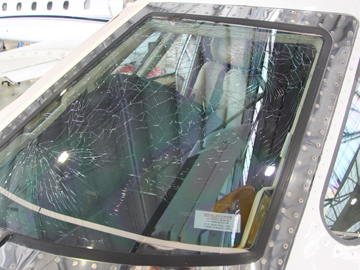
The swift actions of a jet’s flight crew following a shattered windshield in flight has shown how good flight planning can make all the difference.
On 15 January 2013, a Cessna Citation 750 was carrying two flight crew and five passengers from Faleolo, Samoa to Sydney, Australia. The aircraft levelled off at 45,000 feet, when its system reported a problem with the windshield heating system.
The windshields were laminated glass with outer, middle and inner panes of glass. The pilot found that the windshield was warm to the touch, but the only advice the checklist gave was to leave icing conditions as soon as practical.
The cabin was prepared for a possible ditching, with the passengers directed by the flight crew to don their life vests and review the
safety briefing card.
Two minutes later, the outer ply of the windshield shattered with a loud bang. Cracks spread across the entire surface of the left pane.
The flight crew switched off both the left and right windshield heat switches, and completed the emergency depressurisation checklist. They donned their oxygen masks and deployed the passenger oxygen masks.
The pilots commenced an immediate descent along with a turn towards Nadi International Airport, Fiji, which was one of the planned alternate airports. The pilot declared a mayday which was acknowledged by Nadi radio. Once the descent was established, a flight crew member ensured the passengers were on oxygen and briefed them on the situation. The cabin was prepared for a possible ditching, with the passengers directed by the flight crew to don their life vests and review the safety briefing card.
During the descent, the windshield cracking did not progress further. The cabin did not depressurise, and once they were at 14,000 feet and with the cabin altitude stabilised, the passengers were directed to remove their oxygen masks. The flight continued to Nadi without further incident. There were no injuries to passengers or crew.
The ATSB investigation found that the windshield had likely been affected by moisture seeping into the heating equipment, degrading the electrical connections. The manufacturer has taken measures to the address the issue.
While the failure of the windshield did not result in a depressurisation, the precautions taken by the flight crew to descend to a lower altitude and diversion to the alternate airport highlighted the importance of good flight planning.
Read the report: Windshield cracking event involving a Cessna 750, VH-RCA, 460 km south-east of Nadi, Fiji, on 15 January 2013


